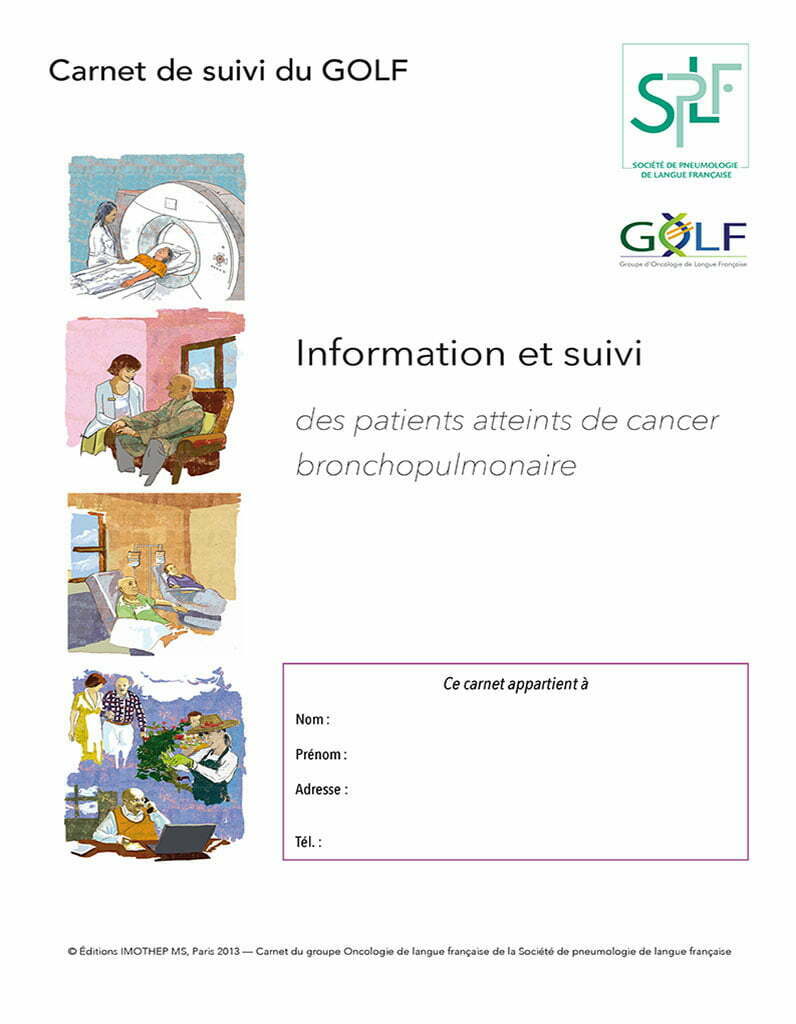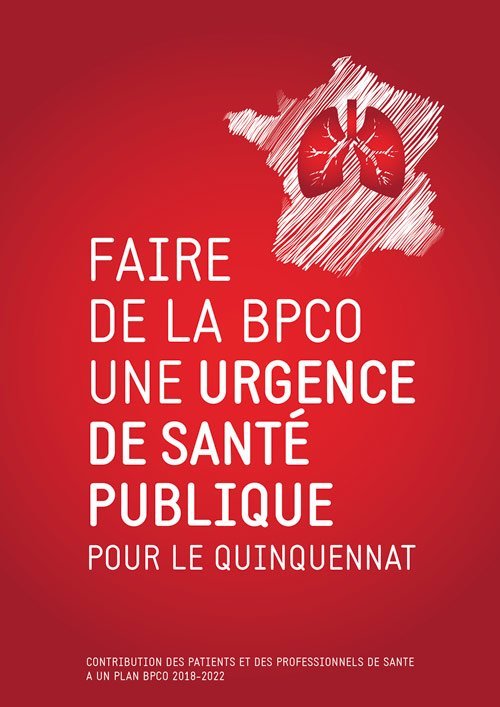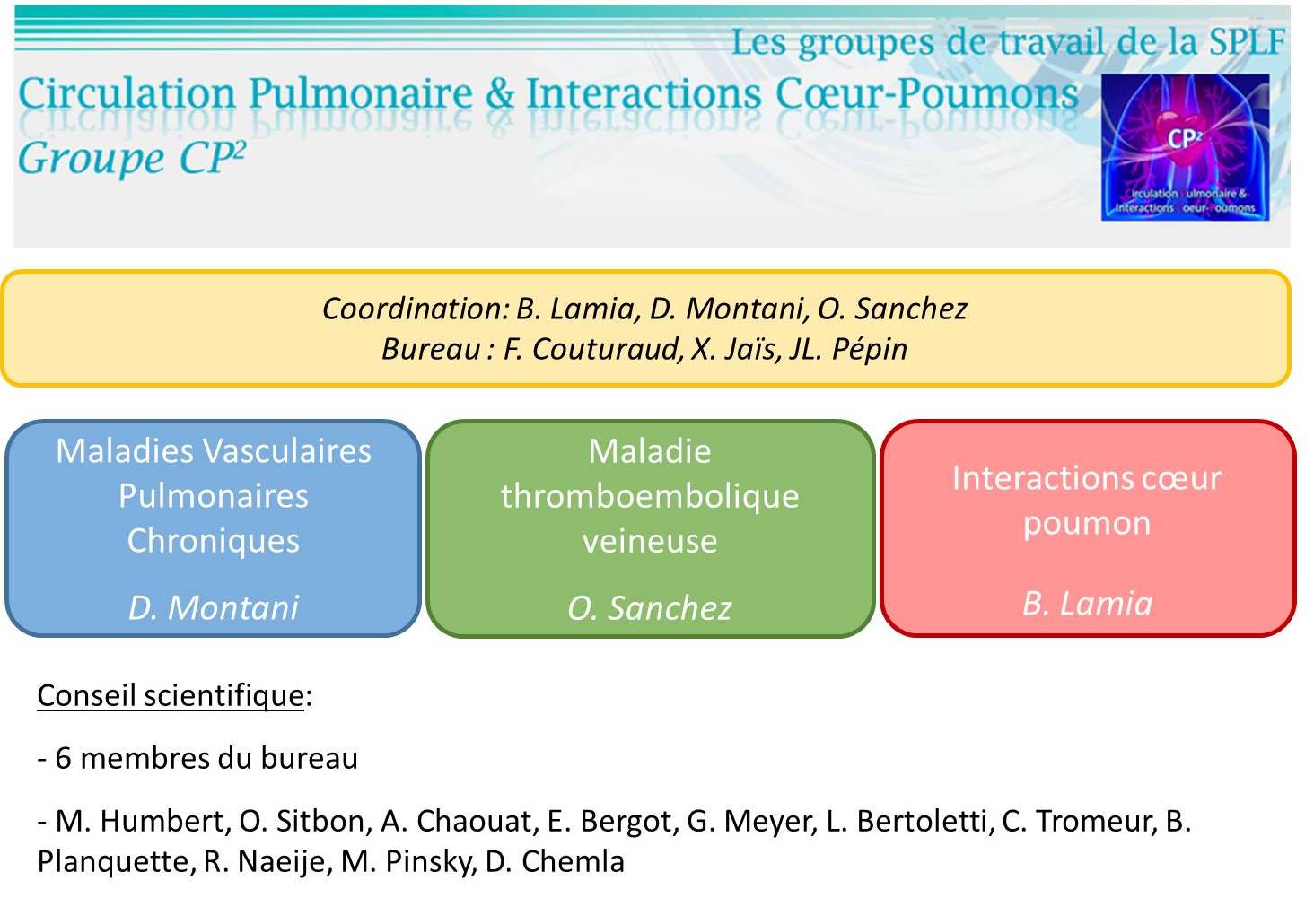Présentation GREPI
Coordinatrice : Claire Andréjak
Les membres du bureau du GREPI
Sous-groupe Mycobactéries : FX Blanc
Sous-groupe santé publique : P. Fraisse
Sous-groupe pathologies chroniques : M. Murris
Sous-groupe Communautaire : M. Fartoukh
Sous-groupe immunodéprimés : vacant
Sous-groupe paramédical : vacant
Représentant CHG : M. Woimant-Gosset
Représentant libéraux : JM Braun
Représentant francophonie : F. Tritar
MAJ 29/01/2018
5èmes journées du Grépi
Les 5èmes journées ont eu lieu du jeudi 30 novembre au vendredi 1er décembre 2017 à Chantilly.

LES DIAPORAMAS disponibles au téléchargement
PROGRAMME MEDECINS
JM1 • Communautaire
> Les nouveautés de l’année > Olivier Le Rouzic (Lille)
> Pleurésies purulentes : de la physiopathologie à la prise en charge > Gilles Mangiapan (Créteil)
> Pneumonie aigue communautaire et bon usage des antibiotiques > Aurélien Dinh (Garches)
JM2 • Immunodéprimés
> Les nouveautés de l’année > Marie-Alice Cornetto (Paris)
> Infections pulmonaires du patient pris en charge pour un cancer bronchique > Julien Mazières (Toulouse)
> Controverse : Faut-il faire un LBA pour l’exploration d’une pneumopathie chez un patient immunodéprimé ?
> Pour > Karine Risso (Nice)
> Contre > Virginie Lemiale (Paris) En attente
JMI-At • Ateliers Médecins – IDE
JMI-At1 > • Que faire d’une PCR pneumocystis positive dans un LBA ? > Nathalie De Castro (Paris)
- Eruption cutanée dans un contexte d’infection respiratoire : origine infectieuse ou toxidermie médicamenteuse ? Saskia Oro (Créteil)
- Histoplasmose pulmonaire : quand y penser ? > Frédéric Rivière (Clamart)
JMI-At2 > • Y a-t-il une place pour la sérologie de la coqueluche ? > Nicole Guiso (Paris)
- Conduite à tenir devant l’apparition d’un infiltrat pulmonaire chez un patient traité par anti-TNF ? > Elodie Blanchard (Bordeaux)
- IRA : Myocardite et infection respiratoire > Vincent Castelain (Strasbourg)
JMI-At3 > • Le coup de froid existe-t-il ? > Marlène Murris-Espin (Toulouse)
- Pharmacogénétique et pharmacocinétique des azolés chez les patients suivis en pneumologie (Hors Mucoviscidose) > Stéphanie Pramil (Rouen), Fabien Lamoureux (Rouen)
- Comment augmenter la couverture vaccinale chez les soignants ? > Cathie Erissy (Paris), Benjamin Wyplosz (Le Kremlin-Bicêtre)
VM1 • Mycobactéries
> Les nouveautés de l’année >Thomas Maitre (Paris)
> Recommandations thérapeutiques des mycobactéries non tuberculeuses > Claire Andréjak (Amiens)
Tuberculose et inflammation : exemple de l’IRIS du non VIH > Anne Bourgarit (Bondy)
VM2 • Infections des pathologies pulmonaires chroniques
> Les nouveautés de l’année > Hélène Morisse-Pradier (Rouen)
> Co-isolement de pathogènes au cours d’une dilatation des bronches > Boubou Camara (Grenoble)
> L’immunosénescence doit-elle faire remettre en cause la vaccination du patient BPCO ? > Jean-Daniel Lelièvre (Créteil)
VM-At • Ateliers Médecins
VM-At1 > • Hémoptysie et infection respiratoire (un cas PAC nécrosante/un cas HIA) > Guillaume Voiriot (Paris)
- Bronchiolite constrictive post-infectieuse > Véronique Houdouin (Paris)
- Aspergillose pulmonaire et BPCO > Cendrine Godet (Poitiers)
VM-At2 > • Quand demander un GenXpert pour le diagnostic de la tuberculose ? > Jean-Louis Herrmann (Garches)
- Que faire d’un granulome histologique ? > Eglantine Haustraete (Lisieux)
- BCGites > Frédéric Schlemmer (Créteil)
PROGRAMME IDE
JI1 • Intérêt de l’ETP dans la prévention des exacerbations du patient mucoviscidosique > Clémence Bae (Toulouse) En attente
JI2 • Infection pulmonaire aigue ou pneumopathie du sujet âgé (hospitalisé)
> Antoine Bizard (Suresnes), Emilie Catherinot (Suresnes)
JI3 • Faut-il isoler tous les patients ayant une infection à virus influenza ou virus respiratoire syncytial ? > Christine Lawrence (Garches)
JI4 • L’intérêt des tests IGRA par rapport au test intradermique pour le dépistage de l’infection tuberculeuse latente > Ariane Luneau-Simonet (Grenoble)
VI1 • La vaccination chez les patients ayant une pathologie respiratoire chronique > Elodie Blanchard (Bordeaux)
VI2 • L’impact de la non observance des traitements inhalés dans la fréquence des exacerbations chez le patient BPCO > Roger Escamilla (Toulouse)
VI3 • La légionellose > Christine Lawrence (Garches)
VI4 • IDE et recherche en infectiologie respiratoire : le bilan > Edith Copol (Paris) En attente
Livre Blanc de la BPCO
Urgence BPCO : les pneumologues et les patients alertent les pouvoirs publics
Télécharger le livre Blanc de la BPCO
Ce Livre Blanc a pu être réalisé grâce à un soutien institutionnel du laboratoire Chiesi. Les modalités de ce soutien ont été formalisées dans une charte, signée par les organisations initiatrices du projet d’une part, par le laboratoire Chiesi d’autre part, dont les grandes lignes figurent en p33 du document. L’objet de cette charte est de garantir la stricte indépendance des associations initiatrices du projet dans le cadre d’un partenariat inédit, moderne, éthique et responsable.
Nouvelle Aquitaine
Cliquez sur le nom de l’établissement pour voir les coordonnées et les pratiques proposées
RÉGION NOUVELLE-AQUITAINE
Creuse
Gironde
Haute-Vienne
Landes
Pyrenées Atlantiques
Clinique Saint-Étienne et Pays Basque
Centre hospitalier de la côte basque
Vienne
CHU Poitiers
Centre Hospitalier Nord Deux-Sèvres (Parthenay)
Bibliographie
Asthme
BPCO
Risque augmenté de BPCO chez les infirmières exposées aux désinfectants de surface
Dr Irène Drogou| 12.09.2017
Source : Lequotidiendumedecin.frLes infirmières exposées de façon régulière aux désinfectants de surface présentent un risque augmenté de bronchopathie chronique obstructive (BPCO), selon une étude présentée ce lundi par le Dr Orianne Dumas de l’INSERM au Congrès international de l’European Respiratory Society (ERS).
Cette étude réalisée auprès de plus de 55 000 infirmières aux États-Unis avec un suivi d’environ 8 ans révèle que l’exposition professionnelle régulière aux désinfectants de surface, et en particulier certains composés chimiques, majore de 22 % à 32 % le risque de BPCO.
Première étude chez les professionnels de santé
Si un lien avait été montré entre asthme et utilisation de désinfectants chez les professionnels de santé, c’est la première étude à mettre en évidence un lien avec la BPCO, peu étudiée, « malgré deux études récentes en Europe montrant que travailler comme agent de nettoyage est associé à un risque de BPCO », explique le Dr Dumas.
Pour ce travail, l’équipe du Dr Dumas a analysé les données de la US Nurses’ Health Study II, qui a débuté en 1989. Les infirmières toujours en activité et sans antécédent de BPCO en 2009 ont été suivies jusqu’en mai 2017. Au cours de cette période, 663 infirmières ont développé une BPCO. L’exposition aux désinfectants était évaluée par questionnaire et par une matrice affectant certaines tâches à l’exposition aux désinfectants. Les résultats étaient ajustés au tabagisme, à l’âge, à l’indice de masse corporelle et à l’appartenance ethnique.
Dans la population étudiée, 37 % des infirmières ont utilisé des désinfectants pour nettoyer des surfaces une fois par semaine et 19 % pour nettoyer du matériel médical, expliquent les auteurs.
Cinq désinfectants pointés du doigt
Une association significative est ressortie pour l’utilisation régulière de désinfectants de surface, c’est-à-dire au moins une fois par semaine, mais pas pour les produits de désinfection du matériel médical. « L’étude suggère un lien entre l’utilisation hebdomadaire de désinfectants pour le matériel médical mais ce n’était statistiquement significatif », explique le Dr Dumas.
En regardant de plus près la composition des désinfectants, les chercheurs ont retrouvé un risque augmenté de BPCO de 24 % à 32 % avec le glutaraldéhyde, l’eau de Javel, l’eau oxygénée (ou peroxyde d’hydrogène), l’alcool et les composés ammonium quaternaires.
Pour les chercheurs, si cette étude observationnelle ne permet pas de conclure au lien de causalité, c’est un élément de plus en faveur de l’impact de l’exposition aux désinfectants sur la santé respiratoire, démontrant « l’urgence d’intégrer des considérations de santé professionnelle dans les recommandations de nettoyage et de désinfection de lieux de soins, comme les hôpitaux », a estimé le Dr Dumas.
Socioeconomic Status, Sex, Age and Access to Medications for
COPD in Ontario, CanadaAndrea Gershon, Michael A. Campitelli, Jeremiah Hwee, Ruth Croxford,
Teresa To, Matthew B. Stanbrook, Ross Upshur, Anne Stephenson & Thérèse A. Stukel (2015)
Socioeconomic Status, Sex, Age and Access to Medications for COPD in Ontario, Canada, COPD:
Journal of Chronic Obstructive Pulmonary Disease, 12:6, 668-679
https://www.tandfonline.com/doi/abs/10.3109/15412555.2015.1020148Abstract
Disparities in COPD health outcomes have been found with older individuals, men and those of lower socioeconomic status doing worse. We sought to determine if this was due to differences in access to COPD medications. We conducted a retrospective cohort study using population health administrative data from Ontario, Canada, a province with universal prescription drug coverage for olderadults. All individuals with COPD aged 67 years and older in 2008 who were not taking inhaled long-acting bronchodilators or inhaled corticosteroids were followed for 2 years. Poisson regression was used to determine the effects of age, sex, and socioeconomic status on the likelihood of initiating one of these
medications, after adjusting for potential confounders. Over the study period, 54,050 of 185,698 (29.1%) older individuals with COPD not previously taking any inhaled long-acting bronchodilators or corticosteroids were initiated on one or more of these medications. After adjustment, individuals of low socioeconomic status, measured using neighborhood income level quintiles, were slightly more likely to initiate COPD medications than those of high socioeconomic status (relative risk (RR) 1.05; 95% confi dence interval (95% CI) 1.02–1.08). While men received COPD medication at a consistent rate across all age groups, the likelihood that a woman received medication decreased with increasing age. With the exception of older women, there was minimal disparity in prescription for COPD medications.
Disparity in health outcomes among Ontario COPD patients is not clearly explained by differences in medication access by socioeconomic status, sex or age.Improving the Management of COPD in Women
Christine R. Jenkins, MDCorrespondence information about the author MD Christine R. JenkinsEmail the author MD Christine R. Jenkins, Kenneth R. Chapman, MD, James F. Donohue, MD, Nicolas Roche, MD, Ioanna Tsiligianni, MD, MeiLan K. Han, MD
COPD is a highly debilitating disease that represents a substantial and growing health burden in women. There is increasing evidence for sex-related differences in COPD risk, progression, and outcomes. However, the disease receives scant attention as a women’s health issue. Thus, a multifaceted approach is required to address COPD in women, including greater awareness, minimization of risk, and further elucidation of the sex-specific factors (biological and cultural) that affect risk, disease progression, and treatment success. This article reviews the current literature on the topic and provides suggestions for achieving better outcomes for the millions of women with COPD worldwide.
CHEST March 2017Volume 151, Issue 3, Pages 686–696
DOI: http://dx.doi.org/10.1016/j.chest.2016.10.031
Gender inequalities in COPD decision-making in primary care
Ana Delgado, Lorena Saletti-Cuesta , , Luis Andrés Lopez-Fernandez ,
Natalia Gil-Garrido c, Juan de Dios Luna del CastilloAbstract
Background: COPD is a frequent severe illness that increasingly affects females. Gender inequalities have been reported in COPD care.
Objective: To analyze decision-making in primary care for men and women with identical COPD as a
function of the gender of the family physician (FP).
Methods: Cross-sectional, multicenter study in 457 Andalusian FPs, using a self-administered vignettebased
questionnaire on COPD featuring a male or female patient, with four variables on clinical
reasoning: “tobacco as most important risk factor (RF)”, “ordering of spirometry”, “COPD as most likely
diagnosis”, and “referral”. Multilevel logistic regression analysis.
Results: Response rate was 67.4% (308/457). In analysis of the four FP gender-patient gender dyads, tobacco
was more frequently considered as priority RF for the man than for the woman in the vignette by
female (95.6%vs.67.1%) and male (79.8%vs.62.5%) FPs. COPD was more frequently the most likely diagnosis
for the man versus woman by female (84.4%vs.49.9%) and male (78.5%vs.57.8%) FPs. Male FPs more
frequently ordered spirometry for the man versus woman (68.1%vs.46.8%). There were no differences in
referral between male and female patients. Male FPs were more likely than female FPs to consider tobacco
as priority RF for the man (p ¼ 002). Female FPs were more likely than male FPs to refer the man
(22.5%vs.8%).
Conclusions: There may be gender inequalities in primary care for COPD in our setting. Diagnostic and
therapeutic efforts appear lower in female patients. Male and female FPs only differed in care of the male
patient, indicating FP gender-patient gender interaction.
© 2016 Elsevier Ltd. All rights reserved.1. Int J Chron Obstruct Pulmon Dis. 2016 Oct 26;11:2681-2690. eCollection 2016.
Management of COPD, equal treatment across age, gender, and social situation? A register study.
Henoch I1, Strang S1, Löfdahl CG2, Ekberg-Jansson A3.
Author information:1Angered Hospital, Research and Development Department; The Sahlgrenska Academy, Institute of Health and Care Sciences, University of Gothenburg, Gothenburg.
2Angered Hospital, Research and Development Department; University of Lund, Lund.
3Angered Hospital, Research and Development Department; Sahlgrenska Academy, Institute of Medicine, University of Gothenburg, Gothenburg, Sweden.Abstract
Chronic obstructive pulmonary disease (COPD) is a progressive chronic disease where treatment decisions should be based on disease severity and also should be equally distributed across age, gender, and social situation. The aim of this study was to determine to what extent patients with COPD are offered evidence-based interventions and how the interventions are distributed across demographic and clinical factors in the sample. Baseline registrations of demographic, disease-related, and management-related variables of 7,810 patients in the Swedish National Airway Register are presented. One-third of the patients were current smokers. Patient-reported dyspnea and health-related quality of life were more deteriorated in elderly patients and patients living alone. Only 34% of currently smoking patients participated in the smoking cessation programs, and 22% of all patients were enrolled in any patient education program, with women taking part in them more than men. Less than 20% of the patients had any contact with physiotherapists or dieticians, with women having more contact than men. Men had more comorbidities than women, except for depression and osteoporosis. Women were more often given pharmacological treatments. With increasing severity of dyspnea, participation in patient education programs was more common. Dietician contact was more common in those with lower body mass index and more severe COPD stage. Both dietician contact and physiotherapist contact increased with deteriorated health-related quality of life, dyspnea, and increased exacerbation frequency. The present study showed that COPD management is mostly equally distributed across demographic characteristics. Only a minority of the patients in the present study had interdisciplinary team contacts. Thus, this data shows that the practical implementation of structured guidelines for treatment of COPD varies, to some extent, with regard to age and gender. Also, disease characteristics influence guideline implementation for each individual patient. Quality registers have the strength to follow-up on compliance with guidelines and show whether an intervention needs to be adapted prior to implementation in health care practice.Cancer
J Occup Environ Med. 2016 Jun;58(6):610-6. doi: 10.1097/JOM.0000000000000722.
Professional Cleaning Activities and Lung Cancer Risk Among Women: Results From the ICARE Study.
Atramont A1, Guida F, Mattei F, Matrat M, Cenée S, Sanchez M, Carton M, Menvielle G, Marrer E, Neri M, Luce D, Stücker I; Icare study group.
Author information
Abstract
OBJECTIVES:
Lung cancer risk associated with occupational cleaning activities has been investigated in the population-based case-control study ICARE.
METHODS:
Occupational history was collected by standardized interviews. Jobs were first defined according to the International Standard Classification of Occupations (ISCO) codes and then categorized according to activity sectors. Adjusted odds ratios (ORs) were estimated by unconditional logistic regression, separately for women (619 cases and 760 controls) and men (2265 and 2780).
RESULTS:
Thirty percent of women and 2.3% of men controls ever held a cleaner or care job. Women who worked as housemaids longer than 7 years showed an OR of 1.76 [95% confidence interval (95% CI) 1.09 to 2.87] with respect to controls. Women employed in domestic service sector for a long time had an OR of 2.06 (95% CI 1.15 to 3.66).
CONCLUSION:
We confirmed and redefined the association of lung cancer with occupational cleaning, which concerns a considerable proportion of women workers.
- PMID:
- 27206119
- DOI:
- 10.1097/JOM.0000000000000722
Hormonal receptors in lung adenocarcinoma: expression and
difference in outcome by sexRossana Berardi, Francesca Morgese, Alfredo et al
© www.impactjournals.com/oncotarget/ Oncotarget, 2016, Vol. 7, (No. 50), pp: 82648-82657[hr]J Occup Environ Med. 2016 Jun;58(6):610-6. doi: 10.1097/JOM.0000000000000722.
Professional Cleaning Activities and Lung Cancer Risk Among Women: Results From the ICARE Study.
Atramont A1, Guida F, Mattei F, Matrat M, Cenée S, Sanchez M, Carton M, Menvielle G, Marrer E, Neri M, Luce D, Stücker I; Icare study group.
Author information
Abstract
OBJECTIVES:
Lung cancer risk associated with occupational cleaning activities has been investigated in the population-based case-control study ICARE.
METHODS:
Occupational history was collected by standardized interviews. Jobs were first defined according to the International Standard Classification of Occupations (ISCO) codes and then categorized according to activity sectors. Adjusted odds ratios (ORs) were estimated by unconditional logistic regression, separately for women (619 cases and 760 controls) and men (2265 and 2780).
RESULTS:
Thirty percent of women and 2.3% of men controls ever held a cleaner or care job. Women who worked as housemaids longer than 7 years showed an OR of 1.76 [95% confidence interval (95% CI) 1.09 to 2.87] with respect to controls. Women employed in domestic service sector for a long time had an OR of 2.06 (95% CI 1.15 to 3.66).
CONCLUSION:
We confirmed and redefined the association of lung cancer with occupational cleaning, which concerns a considerable proportion of women workers.
- PMID:
- 27206119
- DOI:
- 10.1097/JOM.0000000000000722
Grossesse
Determinants of low risk of asthma exacerbation during pregnancy.
Zarqa Ali, Lisbeth Nilas, Charlotte Suppli UlrikClinical and Experimental Allergy : Journal of the British Society for Allergy and Clinical Immunology 2017 Sep 19;
PMID: 28925525
Performance of Low Dose Perfusion Scintigraphy and Computed Tomographic Pulmonary Angiography for Pulmonary Embolism in Pregnancy.
Jean-Ju Sheen, Linda B Haramati, Anna Natenzon, Hong Ma, Pamela Tropper, Anna S Bader, Leonard M Freeman, Peter S Bernstein, Renee M MoadelChest 2017 August 17
PMID: 28823756
Lung cancer during pregnancy: A narrative review
Sotirios Mitrou, Dimitrios Petrakis , George Fotopoulos , George Zarkavelis , Nicholas Pavlidis
© Journal of Advanced Research (2016) 7, 571–574
[hr]American Journal of Respiratory and Critical Care Medicine 2017 Jan 12;
Randomized Controlled Ethanol Cookstove Intervention and Blood Pressure in Pregnant Nigerian Women.
Donee Alexander, Amanda Northcross, Nathaniel Wilson, Anindita Dutta, Rishi Pandya, Tope Ibigbami, Damilola Adu, John Olamijulo, Oludare Morhason-Bello, Theodore Karrison, Oladosu Ojengbede, Christopher O OlopadePMID: 28081369
American Journal of Respiratory and Critical Care Medicine 2017 Jan 11;
Female Smokers are at Greater Risk of Airflow Obstruction than Male Smokers: UK Biobank.
André F S Amaral, David P Strachan, Peter Gj Burney, Deborah L JarvisPMID: 28075609
KPB
Tabac
Autres
Cours du GOLF 2017 – Les présentations
Cliquez sur les titres pour télécharger au format pdf les diaporamas
[themify_box icon=”upload” color=”blue”]Programme[/themify_box]
• Introduction : Pr N Girard, Pr A Vergnenegre
Épidémiologie des CBP
• Les cancers du poumon de moins de 40 ans Dr L. Bigay Game (Taulouse)
• Les formes familiales de cancer bronchique Dr O. Bylicki (Paris)
• Les facteurs de risques professionnels, quelle surveillance? – Pr J-C Pairon (Créteil)
• Le Vapotage: mode d’entrée ou aide au sevrage, Pr T. Urban (Angers)
Diagnostic et prise en charge des CBP
• Une nouvelle classification anatomo-pathologique, pour quoi faire? – Pr S. Lantuejoul (Grenoble)
• La TEP fait-elle partie du bilan initial? Pr J. Monteil (Limoges)
• Les rebiopsies : Comment? Pourquoi? Dr J. Ballouhey (Limoges)
• Les traitements péri-opératoires Pr V. Westeel (Besançon)
• Quand demander une V02 max? Dr L. Boyer (Créteil)
• L’EBUS et le EUS quelle relation? Pour quel résultat? – Dr T. Egenod, Dr R. Legros (Limoges)
CBP et endoscopie thérapeutique
• Les traitements palliatifs et curatifs en endoscopie bronchique – Dr V. Ninane (Bruxelles) CBP et chirurgie
• Les stratégies chirurgicales, quelles nouvelles techniques ? – Pr P-A Thomas (Marseille)
• La chirurgie chez les plus de 80 ans Pr J-F Regnard (Paris)
• La chirurgie des formes oligo-métastatiques Pr L. Brouchet (Toulouse)
• Recist, un petit cours pratique Dr M. Lederlin (Rennes)
BNPC et radiothérapie
• Les nouvelles techniques de radiothérapie Pr P. Van Houtte (Bruxelles)
• Quelle est la meilleure séquence pour les CBNPC non opérables ? – Dr P. Fournel (Saint Etienne)
Les addictions oncogéniques
• EGFR mutés : traitement initial et rechutes Dr R. Gervais (Caen)
• Patients avec réarrangement ALK, traitement initial et rechutes – Dr R. Descourt (Brest)
• Les autres addictions – Dr D. Planchard (Villejuif)
Les patients sans addictions oncogéniques
• Traitement de première ligne et de maintenance en l’absence d’addiction oncogénique – Dr M. Perol (Lyon)
• Deuxième ligne et plus – Pr A. Cortot (Lille)
• Les métastases osseuses – Dr C. Decroisette (Annecy)
• Altérations moléculaires émergentes et anciennes. Quand les rechercher? – Pr M. Wislez (Paris)
Les formes particulières
• Les métastases cérébrales – Dr L. Monnet (Créteil)
• Les méningites carcinomateuses – Dr R. Veillon (Bordeaux)
• Les personnes âgées – Dr R. Corre (Rennes)
• Les PS supérieurs à 1 – Pr T. Berghmans (Bruxelles)
L’immunothérapie
• L’immunothérapie, où en sommes-nous? –Pr J. Mazières (Toulouse)
• Quelles associations avec l’immunothérapie? –Pr B. Besse (Villejuif)
• Les complications de l’immunothérapie -Dr H. Léna (Rennes)
Conférence :
• Quelle organisation pour les analyses génomiques dans les CBPC –Pr F. Barlesi (Marseille)
Cancer bronchique et Santé Publique
• De privation sociale et cancer bronchique –Pr C. Chouaid (Créteil)
• Accès au marché et nouveaux médicaments- Dr Borget (Villejuif)
• Avons-nous les moyens financiers pour l’immunothérapie? – Pr A. Vergnenegre (Limoges)
Conclusion sur les CBNPC
• Essais cliniques en Oncologie thoracique et Médecine personnalisée: Comment les réaliser en pratique? -Pr J.Cadranel (Paris)
• Quelles innovations dans les organisations de prise en charge des CBP ? – Pr D. Moro-Sibilot (Grenoble)
• Essais cliniques en Oncologie thoracique et Médecine personnalisée: Comment les réaliser en pratique? -Pr J.Cadranel (Paris)
• Quelles innovations dans les organisations de prise en charge des CBP ? – Pr D. Moro-Sibilot (Grenoble)
Les autres tumeurs thoraciques
Le mésothéliome – Pr A. Scherpereel (Lille)
Les tumeurs rares – Pr N. Girard (Lyon)
Le mésothéliome – Pr A. Scherpereel (Lille)
Les tumeurs rares – Pr N. Girard (Lyon)
Les cancers à petites cellules (CPC)
• Les traitements de première ligne. – Pr J-L Pujol (Montpellier)
• Que faire en cas de rechute? – Dr L. Greillier (Marseille)
• La place de la radiothérapie dans les CPC. – Dr C. Le Pechoux (Villejuif)
• Les CPC en 2020.- Dr C. Audigier-Valette (Toulon)
• Les traitements de première ligne. – Pr J-L Pujol (Montpellier)
• Que faire en cas de rechute? – Dr L. Greillier (Marseille)
• La place de la radiothérapie dans les CPC. – Dr C. Le Pechoux (Villejuif)
• Les CPC en 2020.- Dr C. Audigier-Valette (Toulon)










Centre Médical National MGEN Alfred Leune